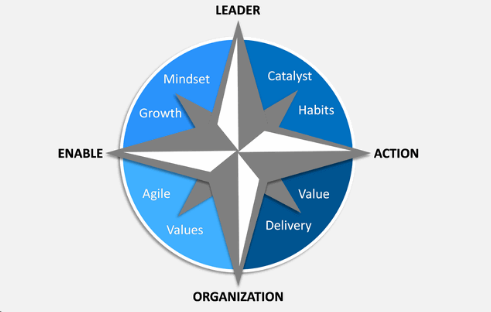The Leadership 6 by 6 is designed to showcase the characteristics of exemplary leadership. Any project or business must have vigilant and encouraging leadership. A complete set of qualities a leader must possess in order to benefit his team is metaphorically represented by the leadership 6 by 6 catchphrase.
There are numerous theories regarding various leadership philosophies. Our favorite is Daniel Goleman’s theory of “6 leadership styles” discussed in his book, Primal Leadership. We like it because it doesn’t only emphasize technical skills, and we concur that great leaders are fundamentally emotionally intelligent and human. This article will walk you through the six different management styles that you will undoubtedly employ.
Table of Contents
Key Takeaways About Leadership Styles
- Visionary: An organization’s goals are pursued by a visionary leader. He, therefore, has a tendency to coordinate action plans with tactics that direct results in the direction of the ultimate objectives.
- Democratic: He will provide equal opportunities and rights for every member of the team if he is a democratic leader. Additionally, it will adjust to any systemic changes.
- A good leader should be commanding in order to maintain order, in addition to being democratic and visionary. Punctuality and discipline are guaranteed by this quality.
- Pacesetting: The leader uses this leadership style to hold himself and his team to high standards. This tactic aids him in achieving his objectives and raising the caliber of his outputs.
- Affiliate: This management style keeps the team and the working environment as the top priorities. By closely collaborating with the members, the leads attempt to create a uniform environment.
- Coaching: In the coaching leadership methodology, team leaders collaborate and provide practical direction to team members as they complete tasks.
When to Apply the 6 Leadership Styles

To begin with, leadership styles refer to the behaviors that leaders use to communicate with their teams. Let’s examine six various styles!
1. the Visionary Leader
Momentum is built toward a common vision by visionary leadership. This approach focuses on guiding your team toward their North Star.
- Key elements: encouragement of innovation, experimentation, and action.
- When should you apply it: When the need for guidance becomes incredibly urgent, adopt this style.
- Importance: Employee motivation and engagement are frequently affected by unclear direction. Teams that have lost focus on their objectives can be reshaped and given a better understanding of where they need to go next with the aid of visionary leadership.
For example, Our goal at Officevibe is to equip managers with the tools they need to run productive teams. Our efforts will be in line with the things we produce if we all share this vision and are reminded of it frequently.
How to become a visionary leader:
- Don’t be timid; be willing to take risks and try new things.
- Accept the possibility of failing before moving on.
- Pick a challenging objective that the entire team can work toward.
- Keep track of the tasks that are leading you in the right direction or away from them. Adjust accordingly.
- Communicate with. motivation the team’s vision and set clear team expectations
- Ask for assistance from your team; visionaries delegate. Encourage them to share their strengths and express diverse perspectives
2. the Coaching Leader
Coaching leaders adopt a coaching mentality to support the growth of their team members’ skill sets and motivate them to maximize their potential in order to show off their strengths. Coaching involves assisting others in assuming their new roles, feeling challenged, and receiving support.
- Key elements: encourages improvement and confidence.
- When should you apply it: especially in growing teams, as work gets more complex, you’ll team will need more than clear objectives. Your encouragement will be necessary for them to develop their skills and abilities so that they can gain confidence in their capacity to perform.
- Importance: To avoid adopting a micromanaging mindset, a great manager and leader aims for balance. Make the appropriate tools and resources accessible so that workers feel prepared for success. A strong connection with your teams can be forged with the aid of this style.
For example: Because it enables managers to schedule regular check-ins and continuously maintain career-goal conversations, managers at Officevibe adore our one-on-one software feature. Our teams are engaged in more than just to-do list completion. Together, they strive to excel in their respective fields.
How to become a coaching leader
- Hold frequent 1-on-1 meetings with your team.
- Encourage employees’ strengths by giving them thoughtful feedback.
- To maximize each team member’s potential, reflect with them and discuss what they are doing well.
Try Officevibe for free if you’re looking for a tool to automate feedback in your team. You will obtain all the information required to prioritize the needs of your team by answering our scientifically sound questions.
3. the Affiliative Leader
When a manager is at ease making friends across the organization, this is referred to as affiliative leadership. The goal is to create a pleasant workplace where staff members can feel like they have developed a sense of camaraderie and comfort with one another.
- Key elements: interpersonal relationships, a delegation of tasks, trust, and collaboration within the group.
- When should you apply it: if you sense a lack of connection between teams? This working style is crucial in a remote work environment where it’s easy to work in silos and become cut off from what’s happening.
- Importance: The affiliative leader’s signature is resolving team conflict. They encourage collaboration among teams and help siloed employees grow.
For example, We made the decision to go digital-first in response to the pandemic’s escalation. Our organization’s leaders, however, were keen to preserve the sense of community that had long characterized our team culture. Our leaders met the challenge head-on by collaborating and using Officevibe to gather feedback. They created a comprehensive plan to maintain the health and connection of our teams using the insights they gained.
How to become an affiliative leader
- Create a culture of reward. Employees are more likely to contribute and form deep connections when they feel valued.
- encourage team building among employees. Regularly hold team-building exercises that highlight people’s communication preferences and strengths.
- Be honest when having difficult discussions. To encourage vulnerability among the team, make sure you create a supportive and secure environment.
- As a starting point, moderate conversations and promote openness and kindness.

4. the Democratic Leader
In democratic leadership, the manager knows how to implement inclusive next steps cooperatively and places a focus on fostering healthy progress for everyone, at all levels.
- Key elements: a strong sense of collaboration, problem-solving, process management, and implementation.
- When should you apply it: This strategy is useful when it’s important to get everyone’s opinion in order to support choices and long-term planning that will have an impact on the entire team.
- Importance: Diverse solutions are supported by collective intelligence. Your team can achieve common objectives and do so in an effective manner with the assistance of this leadership style.
For example: Over the years, Officevibe has expanded incredibly quickly. We wouldn’t be able to keep up with the pace of work if our managers weren’t actively working to put in place systems and procedures that make sense to the dynamics of our team. Managers see to it that everyone has access to the groups and resources they require to perform their duties.
How to become a democratic leader
- Have faith that your team will be there for you and each other. Encourage the intelligent, capable individuals you hired to succeed.
- Be clear about your communication preferences and goals.
- Clearly state your goals and offer a solid framework for brainstorming with the team.
- Examine data-driven outcomes that can inform decisions using a pulse survey tool.
- Be sure to give each suggestion equal weight and explain whether or not it will be taken into account in the following steps.
5. the Pacesetting Leader
A pacesetter focuses on the specific objectives they have set for their group. High standards and a quick pace are characteristics of pacesetting leaders. They ought to combine intense leadership with a potent reward system.
- Key elements: decision-making, clarity of expectations, critical thinking, a sense of volatility, recognition practices, and recognition as part of the team’s culture.
- When should you apply it: this style is most effective with short-term goals. It is advisable to first consider whether this level of pressure is beneficial to your team’s success.
- Importance: You get to witness the rapid growth and value-add of your team. They’ll be inspired to keep up with the group.
For example, We have gained first-hand knowledge of the fact that nothing ever goes as planned. Things can alter in an instant. The swift implementation of new directives and mandates is required. We need pacesetting leaders to step up and lead the way while having faith in their teams to deliver during times of change.
How to become a pacesetting leader
- Make it clear why this is being adopted and that it is a temporary measure.
- Make timelines visible and assure them that this is a temporary situation.
- Share the findings, emphasizing what had a positive influence and how they contributed.
- Applaud your team for a job well done. Recognizing individuals and the entire team is equally important.
6. the Commanding Leader
Simply put, this leadership style encourages a mindset based on fear.
This method can come across as harsh, and it typically has a negative impact on the culture of the organization. To put it bluntly, those who inspire fear are viewed as ineffective leaders.
In general, it’s advised to stay away from using this approach unless a situation requires you to act quickly and, even if the decisions you make are unpopular, in an emergency.
If you feel like you have been leading with his style, we recommend:
- Try inspiring your team by leading with openness, empathy, and collaboration rather than being demanding and ordering them around.
- Instead of micromanaging your team, make a space where one-on-one conversations can be productive.
- Try concentrating on your strengths, potential, growth, and progress rather than your weaknesses and unmet goals.
Conclusion
A diverse and effective team will be encouraged by finding a different leadership style that works for your group. Here are some important lessons you can learn that will help you become a great leader and have a transformational impact.
Officevibe gives managers the tools they need to create happy, effective teams. Our pulse surveys can help you identify the needs of your team so you can create an efficient, tailored experience if you’re not sure where to begin. Try it for free!





